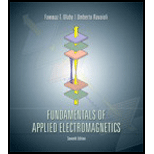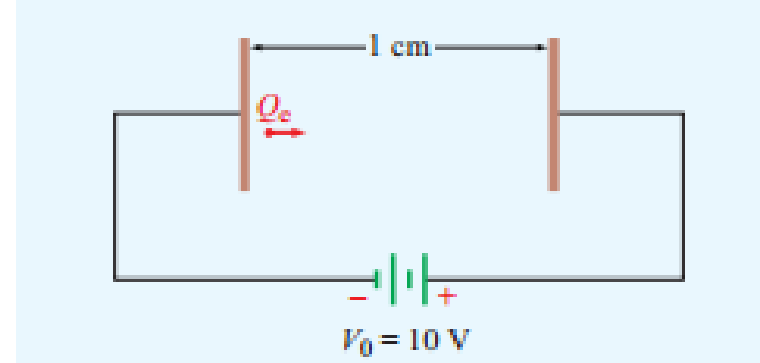
Fundamentals of Applied Electromagnetics (7th Edition)
7th Edition
ISBN: 9780133356816
Author: Fawwaz T. Ulaby, Umberto Ravaioli
Publisher: PEARSON
expand_more
expand_more
format_list_bulleted
Concept explainers
Textbook Question
Chapter 4, Problem 54P
An electron with charge Qe = −1.6×10−19 C and mass me = 9.1 × 10−31 kg is injected at a point adjacent to the negatively charged plate in the region between the plates of an air-filled parallel-plate capacitor with separation of 1 cm and rectangular plates each 10 cm2 in area (Fig. P4.54). If the voltage across the capacitor is 10 V, find the following:
- (a) The force acting on the electron.
- (b) The acceleration of the electron.
- (c) The time it takes the electron to reach the positively charged plate, assuming that it starts from rest.

Figure P4.54 Electron between charged plates of Problem 4.54.
Expert Solution & Answer
Want to see the full answer?
Check out a sample textbook solution
Students have asked these similar questions
A parallel plate capacitor has plates of area 2.56 cm2
spaced by three layers of different dielectric materials.
The relative permittivities are 2, 4, 6 and thickness of
0.5, 1.5 and 0.3 mm respectively. Draw the diagram
a. calculate the capacitance of this capacitor
b. solve for the total charge if the voltage is 50 V
A certain parallel-plate capacitor consists of two plates, each with area 200 cm2, separated by a 0.4 cm
air gap. If the capacitor is connected across a 400-V source. Draw the diagram
a. Determine the energy stored on it.
b. Determine the energy stored if there is a dielectric material with constant of 2.5 inserted between the
plates.
1) First part of the question: Two identical capacitors are connected in
parallel and charged with a 20-V power supply as shown in the figure on
the left. After the charges on the capacitors have reached their final values,
the charge on each capacitor is 10 µC. Then the power supply is
disconnected and a dielectric with K = 4 is inserted to fill the space
between the plates of one of the capacitors. a) Find now the charge on the
capacitor with dielectric. Give your answer in microcoulombs.
Qo = 10 µC
Qo = 10 µC|
Q2 =? ►
V = 20 V
Battery
Chapter 4 Solutions
Fundamentals of Applied Electromagnetics (7th Edition)
Ch. 4.2 - What happens to Maxwells equations under static...Ch. 4.2 - How is the current density J related to the volume...Ch. 4.2 - Prob. 3CQCh. 4.2 - A square plate residing in the xy plane is...Ch. 4.2 - A thick spherical shell centered at the origin...Ch. 4.3 - When characterizing the electrical permittivity of...Ch. 4.3 - If the electric field is zero at a given point in...Ch. 4.3 - State the principle of linear superposition as it...Ch. 4.3 - Four charges of 10 C each are located in free...Ch. 4.3 - Two identical charges are located on the x axis at...
Ch. 4.3 - In a hydrogen atom the electron and proton are...Ch. 4.3 - An infinite sheet with uniform surface charge...Ch. 4.4 - Explain Gausss law. Under what circumstances is it...Ch. 4.4 - How should one choose a Gaussian surface?Ch. 4.4 - Two infinite lines, each carrying a uniform charge...Ch. 4.4 - A thin spherical shell of radius a carries a...Ch. 4.4 - A spherical volume of radius a contains a uniform...Ch. 4.5 - What is a conservative field?Ch. 4.5 - Why is the electric potential at a point in space...Ch. 4.5 - Prob. 11CQCh. 4.5 - Why is it usually easier to compute V for a given...Ch. 4.5 - Prob. 13CQCh. 4.5 - Determine the electric potential at the origin due...Ch. 4.5 - A spherical shell of radius a has a uniform...Ch. 4.6 - What are the electromagnetic constitutive...Ch. 4.6 - Prob. 15CQCh. 4.6 - What is the conductivity of a perfect dielectric?Ch. 4.6 - Prob. 17CQCh. 4.6 - Prob. 18CQCh. 4.6 - Determine the density of free electrons in...Ch. 4.6 - Prob. 13ECh. 4.6 - A 50 m long copper wire has a circular cross...Ch. 4.6 - Prob. 15ECh. 4.7 - What is a polar material? A nonpolar material?Ch. 4.7 - Prob. 20CQCh. 4.7 - What happens when dielectric breakdown occurs?Ch. 4.7 - Find E1 in Fig. 4-19 if E2=x2y3+z3(v/m),1=20,2=80,...Ch. 4.7 - Repeat Exercise 4.16 for a boundary with surface...Ch. 4.8 - What are the boundary conditions for the electric...Ch. 4.8 - Prob. 23CQCh. 4.9 - How is the capacitance of a two-conductor...Ch. 4.9 - What are fringing fields and when may they be...Ch. 4.10 - To bring a charge q from infinity to a given point...Ch. 4.10 - Prob. 27CQCh. 4.10 - The radii of the inner and outer conductors of a...Ch. 4.11 - What is the fundamental premise of the image...Ch. 4.11 - Given a charge distribution, what are the various...Ch. 4.11 - Use the result of Example 4-13 to find the surface...Ch. 4 - A cube 2 m on a side is located in the first...Ch. 4 - Prob. 2PCh. 4 - Find the total charge contained in a round-top...Ch. 4 - If the line charge density is given by l = 24y2...Ch. 4 - Find the total charge on a circular disk defined...Ch. 4 - If J = 4xz (A/m2), find the current I flowing...Ch. 4 - Prob. 7PCh. 4 - An electron beam shaped like a circular cylinder...Ch. 4 - Prob. 9PCh. 4 - A line of charge of uniform density occupies a...Ch. 4 - A square with sides of 2 m has a charge of 40 C at...Ch. 4 - Three point charges, each with q = 3 nC, are...Ch. 4 - Charge q1 = 6 C is located at (1 cm, 1 cm, 0) and...Ch. 4 - A line of charge with uniform density = 8 (C/m)...Ch. 4 - Prob. 15PCh. 4 - A line of charge with uniform density l extends...Ch. 4 - Repeat Example 4-5 for liie circular disk of...Ch. 4 - Multiple charges at different locations are said...Ch. 4 - Three infinite lines of charge, all parallel to...Ch. 4 - Prob. 20PCh. 4 - A horizontal strip lying in the xy plane is of...Ch. 4 - Prob. 22PCh. 4 - Prob. 23PCh. 4 - Charge Q1 is uniformly distributed over a thin...Ch. 4 - The electric flux density inside a dielectric...Ch. 4 - Prob. 26PCh. 4 - An infinitely long cylindrical shell extending...Ch. 4 - If the charge density increases linearly with...Ch. 4 - A spherical shell with outer radius b surrounds a...Ch. 4 - Prob. 30PCh. 4 - Prob. 31PCh. 4 - A circular ring of charge of radius a lies in the...Ch. 4 - Prob. 33PCh. 4 - Find the electric potential V at a location a...Ch. 4 - For the electric dipole shown in Fig. 4-13, d = 1...Ch. 4 - For each of the distributions of the electric...Ch. 4 - Two infinite lines of charge, both parallel to the...Ch. 4 - Given the electric field E=R18R2(V/m) find the...Ch. 4 - An infinitely long line of charge with uniform...Ch. 4 - The xy plane contains a uniform sheet of charge...Ch. 4 - A cylindrical bar of silicon has a radius of 4 mm...Ch. 4 - Repeat Problem 4.41 for a bar of germanium with e...Ch. 4 - A 100 m long conductor of uniform cross-section...Ch. 4 - Prob. 44PCh. 4 - Apply the result of Problem 4.44 to find the...Ch. 4 - A 2 103 mm thick square sheet of aluminum has 5 cm...Ch. 4 - A cylinder-shaped carbon resistor is 8 cm in...Ch. 4 - With reference to Fig. 4-19, find E1 if...Ch. 4 - An infinitely long cylinder of radius a is...Ch. 4 - If E=R150(V/m) at the surface of a 5-cm conducting...Ch. 4 - Figure P4.51 shows three planar dielectric slabs...Ch. 4 - Determine the force of attraction in a...Ch. 4 - Dielectric breakdown occurs in a material whenever...Ch. 4 - An electron with charge Qe = 1.61019 C and mass me...Ch. 4 - In a dielectric medium with r = 4, the electric...Ch. 4 - Prob. 56PCh. 4 - Prob. 57PCh. 4 - Prob. 58PCh. 4 - Prob. 59PCh. 4 - Prob. 60PCh. 4 - Prob. 61PCh. 4 - Conducting wires above a conducting plane carry...Ch. 4 - Prob. 63P
Knowledge Booster
Learn more about
Need a deep-dive on the concept behind this application? Look no further. Learn more about this topic, electrical-engineering and related others by exploring similar questions and additional content below.Similar questions
- A capacitor uses air as a dielectric and has a capacitance of 3 F. A dielectric material is inserted between the plates without changing the spacing, and the capacitance becomes 15 F. What is the dielectric constant of this material?arrow_forward4. In what form is the energy of a capacitor stored?arrow_forwardThree capacitors having capacitance values of 20F,40F, and 50F are connected in parallel to a 60 - Hz power line. An ammeter indicates a circuit current of 8.6 amperes. How much current is flowing through the 40F capacitor?arrow_forward
- Can current flow through a capacitor?arrow_forwardQuestions Q1- Prove that the voltage on a capacitor reach 63% from the final voltage after T time (charge state).arrow_forwardA parallel plate capacitor with 5 parallel plates has plates each 1 m 2 at a distance of 1.5 mm and a dielectric of relativepermittivity 3.5. If the capacitor is charge to a 1000-Volt supply, how much energy will be stored in it?arrow_forward
- At a potential of 7000 V, a simple parallel-plate capacitor will be built to store charge. The capacitor has a separation distance of 0.21 mm between plates and a plate area of 0.030m2.The dielectric constant of a material with a dielectric constant of 6.5 is positioned.in the space between the plates Compute the capacitance of the capacitor and compute the magnitude of the charge stored on each plate.Then,If the capacitance in above has to be increased, choose one acceptable dielectric material from Table 2 below to use between the plates.Justify your mathematical decision.arrow_forwardIn the box below, show that the time constant r is the time it takes the voltage across a discharging capacitor to reach the value V0/e.arrow_forwardA ceramic capacitor has an effective plate area of 4 cm2 separated by 0.1 mm of ceramic of relative permittivity 100. Calculate the capacitance of the capacitor in picofarads. If the capacitor in part is given a charge of 1.2 µC what will be the p.d. between the plates?arrow_forward
- Find the capacitance (in pF) of parallel-plate capacitor containing two dielectrics with ert = 1.5 and er2 = 3.5, each comprising one-half the volume. The area of the plates is 20 cm2 and the distance between them is 1 cm. O 6.64 O 4.43 O 7.30 5.81arrow_forwardSolve for the following: a. Equivalent capacitance b. Magnitude of charges c. Potential difference across the capacitors d. Energy stored in each and both capacitorsarrow_forwardAn air-filled parallel-plate capacitor has plates with an area of 2.5 cm² separated by 1.5 mm. The capacitor is connected to a 12.0-V battery. What is the charge on the capacitor and the magnitude of the uniform electric field between the plates?arrow_forward
arrow_back_ios
SEE MORE QUESTIONS
arrow_forward_ios
Recommended textbooks for you
 Delmar's Standard Textbook Of ElectricityElectrical EngineeringISBN:9781337900348Author:Stephen L. HermanPublisher:Cengage Learning
Delmar's Standard Textbook Of ElectricityElectrical EngineeringISBN:9781337900348Author:Stephen L. HermanPublisher:Cengage Learning

Delmar's Standard Textbook Of Electricity
Electrical Engineering
ISBN:9781337900348
Author:Stephen L. Herman
Publisher:Cengage Learning
Capacitors Explained - The basics how capacitors work working principle; Author: The Engineering Mindset;https://www.youtube.com/watch?v=X4EUwTwZ110;License: Standard YouTube License, CC-BY